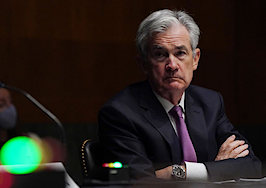Barring any unforeseen bumps on the road to economic recovery, the Federal Reserve is ready to begin tapering its purchases of government bonds and mortgage-backed securities later this year.
Although the Fed did not set a formal timeline for when tapering will begin, it sent a clear message to investors that it’s preparing to scale back monthly purchases of $80 billion in bonds and $40 billion in mortgages. Those purchases — an emergency measure intended to keep borrowing costs low during the pandemic — have swollen the Fed’s debt holdings to nearly $8 trillion.
“While no [final decisions have been] made, participants generally view that so long as the recovery remains on track, a gradual tapering process that concludes around the middle of next year is likely to be appropriate,” Federal Reserve Chairman Jerome Powell said Wednesday, at the conclusion of a two-day meeting of the Federal Open Market Committee.
The Fed’s debt purchases are credited with keeping long-term interest rates low during the pandemic. Rates on 30-year fixed-rate mortgages hit an all-time low of 2.65 percent during the week ending Jan. 7, 2021, according to records maintained by Fannie Mae dating to 1971.
The purchases “were very, very important in the early stages of the crisis,” Powell said. “Now we are in a situation where they still have a use, but it’s time for us to begin to taper them. Their usefulness is much less as a tool than it was at the very beginning.”
By telegraphing its intentions, the Fed may avoid creating a “taper tantrum” by bond investors that sends interest rates soaring. Bond markets took the Fed’s latest policy stance in stride. Yields on 10-year Treasury notes — which can be a good indicator of where mortgage rates are headed — rose only modestly during Powell’s press conference, to 1.34 percent.
Members of the Federal Open Market Committee who are in favor of tapering have aired those views in public for weeks, and Powell said last month that “if the economy evolved broadly as anticipated, it could be appropriate to start reducing the pace of asset purchases this year.”
Although a statement issued by the committee said only that tapering “may soon be warranted,” that stance sets the stage for its members to authorize tapering at their next meeting, which wraps up on Nov. 3.
Fed quantitative easing approaching $8 trillion
The “quantitative easing” the Fed has undertaken during the pandemic was always intended to be a temporary measure. When the pandemic hit, the Fed was in the process of unwinding more than $4 trillion in debt taken on during the Great Recession of 2007-09.
Usually, the Fed’s main monetary policy tool is to adjust the short-term federal funds rate, the rate banks charge each other for overnight loans.
The federal funds rate
Powell said The Fed won’t start raising the short-term federal funds rate, which is currently near zero, until it’s done tapering.
“The timing and pace of the coming reduction in asset purchases will not be intended to carry a direct signal regarding the timing of interest rate lift off which we have a more stringent test for,” Powell said.
The “dot plot” released after the meeting revealed that members of the committee expect the Fed to hike the short-term rate six to seven times by the end of 2024, bringing the federal funds rate to around 1.8 percent.
The dot plot “does not represent a committee plan, and no one knows for certain where the economy will be a year or more from now,” Powell said. “More important than the forecast is that policy will remain accommodative until we have achieved our maximum employment and price stability goals.”
The Fed’s goal is to provide enough economic stimulus to achieve “maximum employment,” without letting inflation run far above a long-term target of 2 percent.
“The downturn has not fallen equally on all Americans,” Powell said. “Despite progress, joblessness continues to fall disproportionately on lower wage workers in the sector and African Americans and Hispanics.”
In their Summary of Economic Projections, committee members projected that the unemployment rate will drop to 3.8 percent next year, and bottom out at 3.5 percent in 2023 and 2024. Members also think inflation will moderate, falling from 4.2 percent this year to 2.2 percent in 2022.
Acknowledging the toll that the Delta variant took on the economy during the third quarter, the committee said it now expects the economy to grow by 5.9 percent in 2021, down from the 7 percent projected in June.
“The path of the economy continues to depend on the course of the virus,” the committee said in its latest policy statement. “Progress on vaccinations will likely continue to reduce the effects of the public health crisis on the economy, but risks to the economic outlook remain.”






